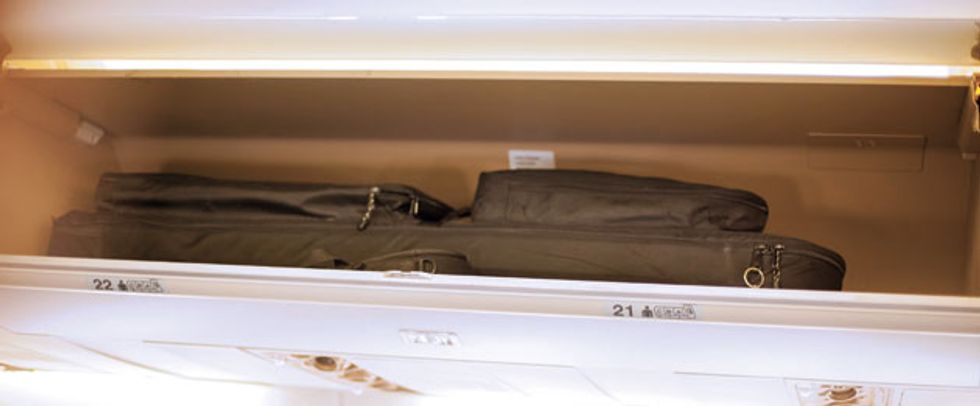There are a few extra challenges that come with the bass guitar being just a little bit bigger and, more importantly, longer than a standard guitar. At 6’2” and 190 pounds when I was 14, however, I was happy that the bass was a little bigger. I always thought I looked like a guitarist playing a mandolin whenever I strapped on a standard guitar, so I definitely picked the right instrument for my size.
Growing up, I remember seeing many of my bass heroes (mostly heavy metal), like Steve Harris of Iron Maiden, playing a Precision. These basses looked huge on some of these guys—like battle axes or Viking swords.I spent a few years coveting a P bass before I could actually afford one and spent those years with a short-scale Gibson EB-3 knockoff. At 18, when I finally got my first P, I strapped it on at home (in front of a mirror, of course) and my disappointment was monumental. The bass on me looked like a Strat or Les Paul on one of my slightly less tall guitarist friends. Since then, I’ve gravitated towards at least traditional-sized or larger bass guitars. A 35"-scale instrument doesn’t scare me at all. I even sought out a rare, long-scale Flying V bass that would make someone my size look small. We all want our instruments to sound great and look cool, and the size-to-human-body ratio has obviously been my thing to obsess over.
No space for bass? I’ve spent quite a few years as a full-time touring bassist. While I love my session work, bringing the music to the people live is my primary passion and why I wanted to be in this industry so badly in the first place. There is something very gratifying about the instant approval from a crowd, and in this day and age when recording is so easily manipulated, I feel that the one-take energy of a live show is what separates great from good musicians. So let’s dive into some of the challenges we bassists encounter when travelling with a bass, and how to manage those few extra inches.
For starters, a standard guitar will typically fit in the trunk of many small cars, both sideways and straight in. In my slightly smallish Audi A5, my hardshell bass case will not fit. My only option is to use a gig bag, load the bass diagonally into the trunk, and close the lid with extreme caution. In some of my friends’ cars with slightly bigger back seats, we can easily stand guitars straight up on the floor behind the front seats and still have plenty of room to set a suitcase or a pedalboard on the back seat right behind the guitar. To do the same thing with a bass guitar, one has to angle the bass into the back seat to avoid the frame of the car door, and then slowly move the bass up to a standing position.
The biggest and most obvious challenge is flying with a bass. I see a lot of folks asking for advice on this topic on online forums and the like, so I’ll offer my two cents on the matter. Many people assume that checking an instrument in an approved hardshell fly case is the way to go. It’s certainly an option, but flight cases can be very expensive. And unless you only fly Southwest or are a premium credit-card holder with another airline that might allow you one checked item for free, you’re going to pay to check your bass.
The big air scare. Have you ever sat in a window seat above the baggage door of a plane’s fuselage and watched the bags get loaded onto (make that thrown onto) the conveyor belt and into the plane? That experience alone will make you pensive for life as far as checking an instrument goes. Of course, this leaves carrying your bass onto the plane as your only other option, which can be scary if someone tries to shove their roller bag into the same overhead compartment and hits your instrument’s neck in the process. My trick to avoid that scenario is having one or both guitarists in the band put their guitars in the same overhead compartment as my bass. This also usually makes the cabin crew happier since you won’t appear to be hogging an excessive amount of overhead space with your instrument.
The other useful trick is to put your smaller carry-on item in front of your instrument’s neck. This may be frowned upon, since you are supposed to keep your smaller item by your feet, but it’s sometimes necessary in order to protect your baby. (Those extra inches on your bass will also help ensure that nobody else will try and fit another bag in the bin.)
Finally, and most importantly, the Federal Aviation Administration made it illegal in 2012 for gate agents and cabin crew to deny your carrying a bass on ifthe overhead bins or closet can fit it. While this was a big victory for us musicians, many airline employees still seem unaware of the details. Printing out a copy of the law [FAA Modernization and Reform Act of 2012,SEC. 403. MUSICAL INSTRUMENTS] and carrying it with you is always a good idea.
Remember: Don’t let anybody make you feel bad about those extra few inches.






![Rig Rundown: AFI [2025]](https://www.premierguitar.com/media-library/youtube.jpg?id=62064741&width=1245&height=700&quality=70&coordinates=0%2C0%2C0%2C0)












 Shop Scott's Rig
Shop Scott's Rig















































